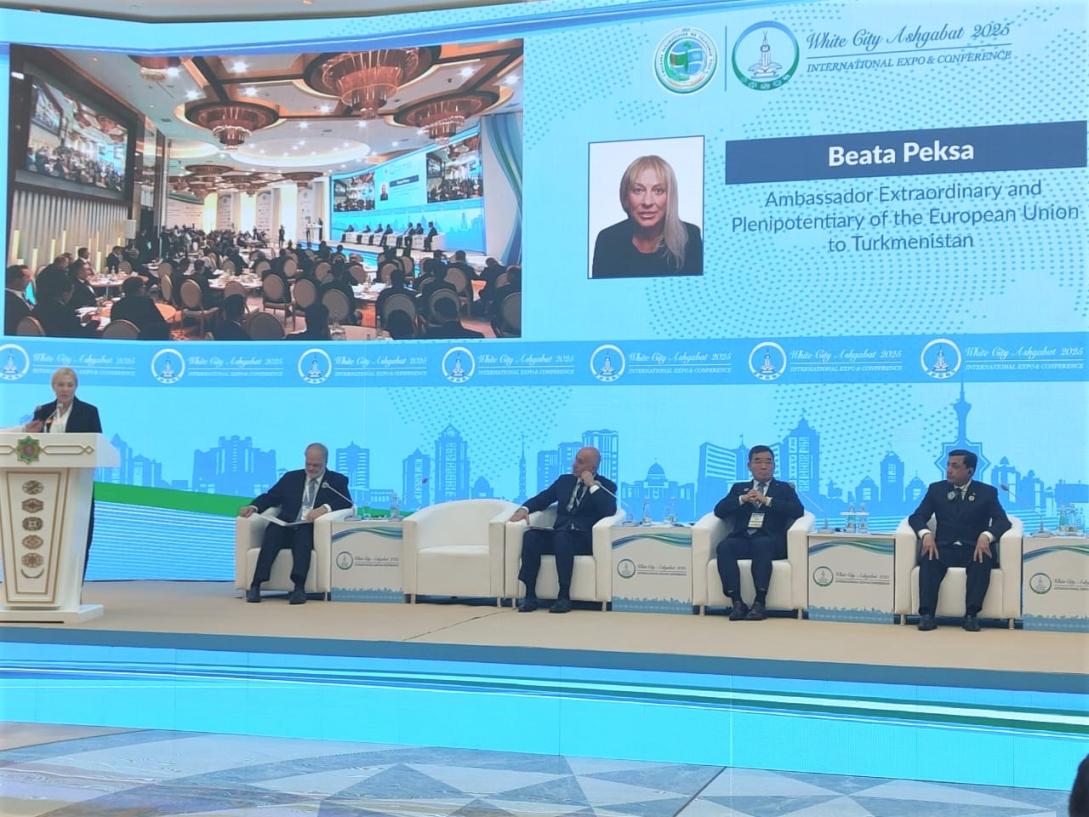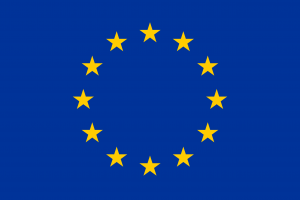Speech by the Ambassador of the European Union to Turkmenistan, Ms Beata Pęksa, at the “White City Ashgabat” International Forum

Excellencies, Distinguished guests, Ladies and gentlemen,
It is an honour to address you today at the opening of this important Conference on "The White City of Ashgabat."
This gathering is not just about beautiful architecture; it's about a vision for the future – how we can jointly advance green technologies in infrastructure and transport, and do so in a way that is smart, inclusive, and respectful of people, nature, and animals.
In the European Union, we view sustainable development not only as an environmental necessity but as a powerful engine for innovation, prosperity, and human dignity.
Through our Global Gateway Strategy, we are deeply committed to partnering with countries in Central Asia – and Turkmenistan is a key partner in this – to promote resilient, efficient, and climate-neutral systems.
These efforts are not just ideas on paper. They are already taking shape on the ground.
Earlier this year, I had the opportunity to visit the Turkmenbashi Port – a vital connection along the Trans-Caspian Transport Corridor. We see there a real momentum towards modernisation. The EU is ready to support such efforts, not just by investing in infrastructure, but also by bringing in smart and sustainable transport technologies that reduce emissions and encourage green logistics.
However, the transition is not just about big corridors and cargo. It must also be about how people live, move, and interact with their surroundings in our cities. That is why the EU places a strong emphasis on approaches to urban development that put people and nature first.
We believe that roads, parks, and transport systems should be designed with universal accessibility, safety, and dignity in mind – where everyone, including children, elderly persons, people with disabilities, animals and pets, can move freely and safely.
Let's talk about how we can make our cities, like beautiful white Ashgabat, truly resilient and pleasant places to live.
-
First, adapting our cities to climate change is crucial. This means better architecture, more trees, and more green spaces. A study on European cities estimated that increasing tree coverage to 30% could lower average temperatures by 0.4°C, with a maximum effect of up to 5.9°C in some areas, potentially preventing thousands of heat-related premature deaths.
We have learned important lessons in Europe. For example, in some cities like those in Poland, we once saw rapid development lead to many trees and green areas being removed and concrete laid down, which contributed to rising urban temperatures. Studies on Polish cities, such as Łódź, have shown a clear urban heat island (UHI) effect, where city centers can be 1.5°C to almost 5°C warmer than surrounding rural areas, particularly at night. Now, we are actively working to reverse this trend, planting trees and creating green parks and spaces again to cool our cities, improve air quality, and enhance biodiversity. For instance, cities like Warsaw are implementing comprehensive Green Building Standards for municipal investments, prioritizing energy efficiency and green infrastructure.
-
Second, accessibility for everyone is a core value. Cities should be welcoming to all. This means ensuring easy access for people with disabilities, through features like ramps, tactile paving, and accessible public transport. When we design for the most vulnerable, we make the city better for everyone.
But it also means considering the needs of families – for example, making sure there are smooth pavements and easy access for baby strollers and prams. Also, if we want our population to grow, we need to give young families help in the city - free nurseries and kindergartens, medical care, so-called "large family cards" - discounts on transport and culture, so that they can work and develop professionally at the same time, but also feel safe creating new families.
-
Third, we need to think about better city communication and transport. This means encouraging alternatives to private cars to reduce pollution. Introducing and expanding public transport options, combined with safe and widespread bicycle lanes, not only helps the environment but also improves public health and the quality of urban life. It creates a more breathable and enjoyable city.
For instance:
-
Public transport can significantly reduce emissions: Doubling public transport usage globally by 2030 could cut urban transport emissions in half and reduce air pollution from transport by up to 45%.
-
Studies have shown that metros can cut population-related CO2 emissions by 50%.
-
Cycling offers substantial environmental benefits: Copenhagen, capital of Denmark, is a world leader in cycling. With a substantial investment in cycling infrastructure, almost half of its residents (47%) use bicycles for their daily commute. This extensive network of over 500 kilometers of dedicated bike lanes contributes to preventing an estimated 90,000 tons of CO2 from being emitted each year.
-
Studies across 167 European cities indicated that by expanding cycling networks of 25%, over 10,000 premature deaths could be avoided annually due to increased physical activity and reduced air pollution.
-
Fourth - Strengthening small trade and services. While large malls and fairs give an impression that they save time for shopping and are entertainment for families, small shops, hairdressers, shoemakers, small restaurants who are available on foot should be respected and their owners should be given best assistance for running their businesses and serving city citizens.
-
It is also necessary to ensure that smart cities also mean access to information and city applications at every step; that high-speed internet is in every home, office and school, and that wi-fi spots are available on the streets.
-
To give you two examples from two EU cities:
-
Recognized as a pioneer in free public Wi-Fi, Tallinn offers free internet access in almost all public spaces, including parks, squares, cafés, and even forests. Internet access is considered a universal right, and Estonia was the first country to allow online voting.
-
Barcelona boasts one of Europe’s largest free Wi-Fi networks, with nearly 2,000 hotspots throughout the city, especially in popular districts like the Old Town, Eixample, Sants, and Gràcia. This service has been available since 2011
-
EU-funded program WiFi4EU provides free high-speed Wi-Fi in public spaces such as parks, squares, libraries, and museums across nearly 9,000 municipalities in Europe. Cities like Valencia (Spain), Gießen (Germany), and Kranjska Gora (Slovenia) are notable participants.
-
Finally, let's not forget our silent residents – animals. A truly smart and compassionate city also takes care of its stray animals. This means implementing humane practices like sterilization and vaccination programs for stray dogs and cats, building city-run animal clinic and shelters that provide safe havens, and actively promoting adoption. These efforts reflect a city's commitment to all its inhabitants, human and animal alike.
Consider the progress made in some EU cities:
-
Sofia, Bulgaria, a relatively new EU member state, has been recognized by the European Parliament as a "best practice" example for successfully and humanely reducing its stray dog population. Through concerted efforts, including sterilization, vaccination, and rehoming programs, the estimated stray dog population in Sofia decreased from 11,124 in 2007 to 3,589 dogs in 2020. They have also documented a sterilization rate of over 70% for dogs.
-
The EU is also developing new rules on the welfare and traceability of dogs and cats across the Union, aiming to harmonize standards for housing, care, and handling in breeding establishments, pet shops, and shelters. This also includes strengthening traceability requirements to combat illegal trade. These initiatives reflect a broader commitment to ensuring humane treatment for the more than 72 million dogs and 83 million cats in EU households.
-
Dear participants,
The European Union has supported such visions through various initiatives.
Our Partnerships for Sustainable Cities programme, though now concluding, created a strong legacy by empowering over 57 city-to-city projects globally. It helped municipalities share experiences in climate resilience, urban mobility, and inclusive planning, directly contributing to Sustainable Development Goal 11. This has laid a solid foundation for future bilateral and regional work, especially through initiatives like the Global Gateway.
Currently, we are also promoting sustainable infrastructure through the SECCA (Sustainable Energy Connectivity in Central Asia) project, which offers key support to the green transformation of the building sector. Globally, the floor area of buildings is growing fast, and decisions made today will shape energy use and emissions for decades. Through SECCA, we are sharing EU best practices in energy-efficient and green building design, including promoting cost-optimal energy performance levels and building certification systems.
Importantly, SECCA also supports local universities and research institutions in building capacity to participate in Horizon Europe – the EU’s flagship research and innovation programme – opening doors to joint research in green architecture and smart urban development.
We are encouraged by the enthusiasm we see from Turkmenistan in embracing smart, eco-friendly solutions – such as the recently completed 10 MW hybrid solar-wind power plant near Lake Altyn Asyr, supported on capacity building under the EU-funded SECCA project. The associated trainings for national specialists show the country’s capacity and willingness to lead in this transition.
Also, through our bilateral programme “EU for a Green Turkmenistan” and regional efforts like the Team Europe Initiative on Water, Energy, and Climate – with a current budget of EUR 20 million – we are advancing work on methane reduction, renewable energy deployment, and climate-smart infrastructure planning. These actions also support low-emission urban development and promote greener approaches to transport and construction.
Distinguished guests,
Dear Friends,
Let us not forget that infrastructure is not just steel and concrete – it is a living system. A smart city is not simply a digital one, but one that puts people and nature at the heart of decision-making. A green transport network is one that respects both environmental limits and human needs.
We look forward to deepening our cooperation with Turkmenistan and the wider region in these areas — supporting not only infrastructure investments, but also policy dialogue, technical capacity, and community engagement. Together, we can co-create city systems that are climate-smart, accessible to all, and inspired by the richness of both human and natural life.
Thank you.
